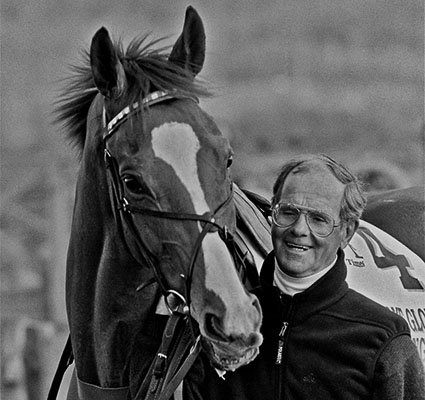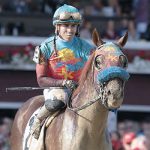Fresh off the New York State Thruway and I’m still having a tough time determining the best thing about the semi annual trek to Lexington.
There are no shortage of choices, considering:
– The Bourbon Chase, an overnight 200-mile 12-person team relay. The squad I captained, Team Runamuck Old Batch was a great group that included racing industry veterans Remi Bellocq and Lucas Marquardt. We were 11 strong – losing a runner the morning of the race, notified via text (poor form) – that clocked a 29:19:06 to finish 149th of 386 teams. That’s an 8:48 per mile pace if you’re scoring at home, not sizzling but still pretty good considering our average age checked in well above 40 (thus Old Batch).
– An afternoon at the races without a press credential, notepad, tape recorder, an assignment or a team of writers to give an assignment. Keeneland does a Sunday as good as any other day of the week and I could help but think, and say to friends, as we hit the exits, “you know, this place really is the best place to take in the races.” Racing as it’s meant to be, indeed.
– Breakfast and lunch on the same day at Sunrise Bakery in Lexington, dinners at Lebanese restaurants in Lexington and Cincinnati, dinner at a staple Mexican spot in Lexington and the all-important mandatory stop at Skyline in Cincinnati while visiting the in-laws. Note to Saratoga, lighten up on the bistro theme and go for something original with character and flavor.
– Catching up with friend and summertime neighbor Charlie LoPresti, talking team penning, chickens, new carports, farm life, turkey dinner at the Olde Bryan Inn and of course Wise Dan, before he was knocked out of the Breeders’ Cup.
– Visiting family, other friends, colleagues (old and new) and clients. Always bummed to miss a few – Jeremy and Ella, Chuck, Damien and Erin, Catlyn, Kelly and Ben … we’ll get you next time.
– Emptying and closing my safe deposit box at PNC Bank on Tates Creek Road, taking home my grandfather’s pocket watch, my father’s Army pins and buttons and realizing I had a second birth certificate. Who knew? (For the record, I should have closed the box last spring or last fall, but forgot the keys!)
I definitely could pick any of those, but the winner upon return from Cincinnati Tuesday night and back in the office Wednesday morning revealed itself in the five boxes picked up at the Keeneland Library not an hour after I arrived in Lexington.
Inside the boxes are books, 30 books to be precise and they are copies of the American Racing Manual bought at a book sale held last spring at the Keeneland Library.
A florescent tag that hangs from one reads “ARM, 1950-1979” and soon enough they’ll be on the shelves and part of my personal racing library.
But first things first and before they get stacked in a neat line, earliest to latest left to right.
Many are marked “Property of Thoroughbred Record” or “Editorial Department, Thoroughbred Record” on the inside front cover. Still a few others are branded “Advertising Department.”
Not surprisingly the editions from the 1950s are a bit beat up, more so than the ’60s volumes, which are in slightly worse shape than the those from the ’70s.
The 1950 edition, with the hand written “E. Berger” on the first page after the inside cover, features the review of races from 1949, since the ARMs always cover the prior year’s events. The official “Review of 1949 Races” that starts out the edition was written by Evan Shipman – who was a real person, not just the name of a New York-bred stakes race at Saratoga – and in it he outlines “three most serious problems the sport had to face during the past season, the second and third deriving from the first.”
According to Shipman, the problems were “excessive state and local taxation; the possibility that some associations might resort to night racing; [and] recommendations for the legalization of ‘off-course’ wagering.”
Capot was Horse of the Year and champion 3-year-old colt in 1949 so his victories in the Preakness and Belmont, along with the clinching score in the Pimlico Special by 12 lengths over Coaltown, were highlighted.
A little further in, on page 85 and included in “Part III. Racing Statistics of 1949,” Santa Anita Park is listed as the track that distributed the most money to horsemen in 1949, dishing out purses of $2,590,900.
Saratoga, which will easily be the leader in 2014, ranked 13th in 1949 at $1,224,945. Ahead of the Spa were seven track – Detroit, Hollywood Park, Suffolk Downs, Garden State Park, Jamaica, Empire City and Hialeah – that are either shut down, about to shut down or significantly different.
The 1979 copy, with the handwritten “Dan Mearns” and a red stamp reading “Photo by Thoroughbred Record” tells a little different story of the state of racing in the U.S. The 1978 season certainly was part of the game’s golden age and three of the year’s champions – Horse of the Year and 3-year-old male Affirmed, 2-year-old male Spectacular Bid, and older male Seattle Slew – are arguably three of the 10 best racehorses in American history.
By 1978 records were set for the number of races (69,499), starters (62,950) and purses distributed ($367,637,193) in North America. The ranking of purses given out were gone from this edition, but a quick glance shows the Belmont Park fall meeting leading the way with an average daily distribution of $166,210 for its 50 days (the 2014 season is 38 days), just ahead of Hollywood Park’s $166,019 for its 78-day spring and summer meet.
That’s a mere snippet of the information buried in these volumes.
No doubt it would take quite a bit longer than the 29-plus hours of the Bourbon Chase to uncover all the interesting factoids.








